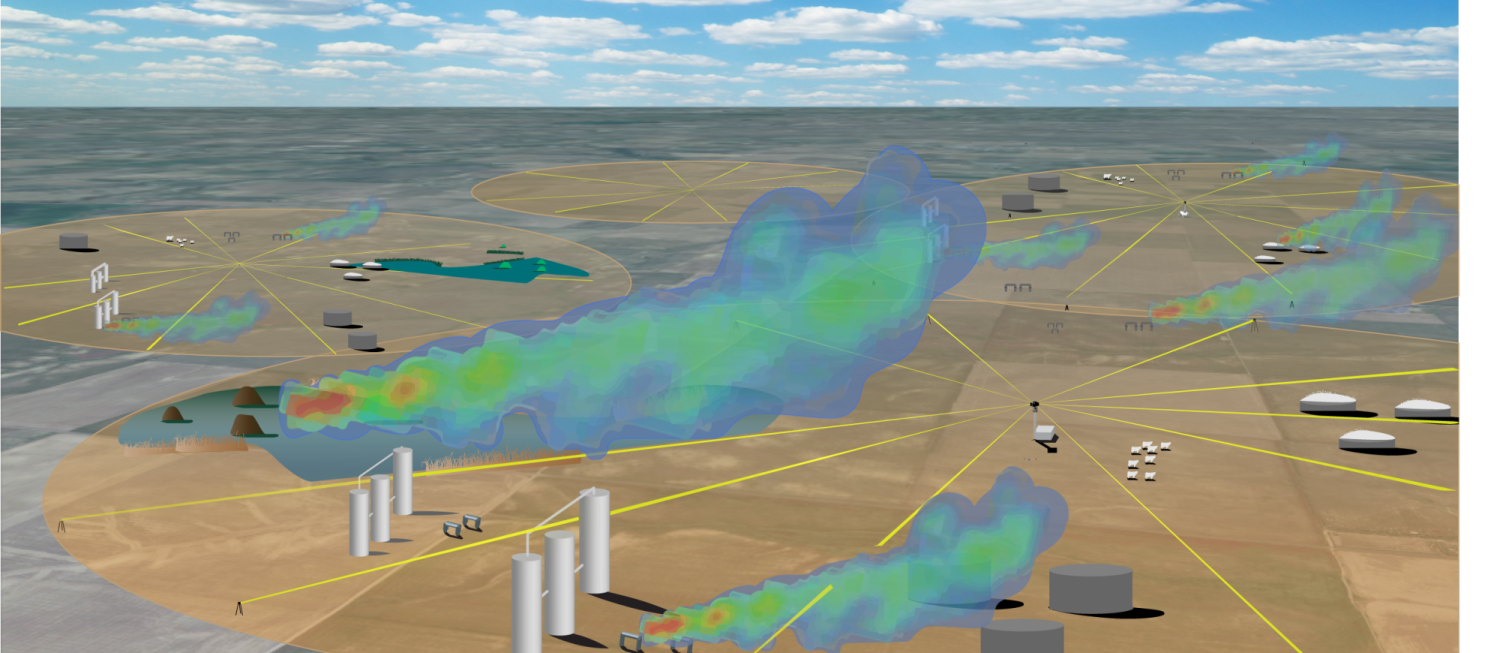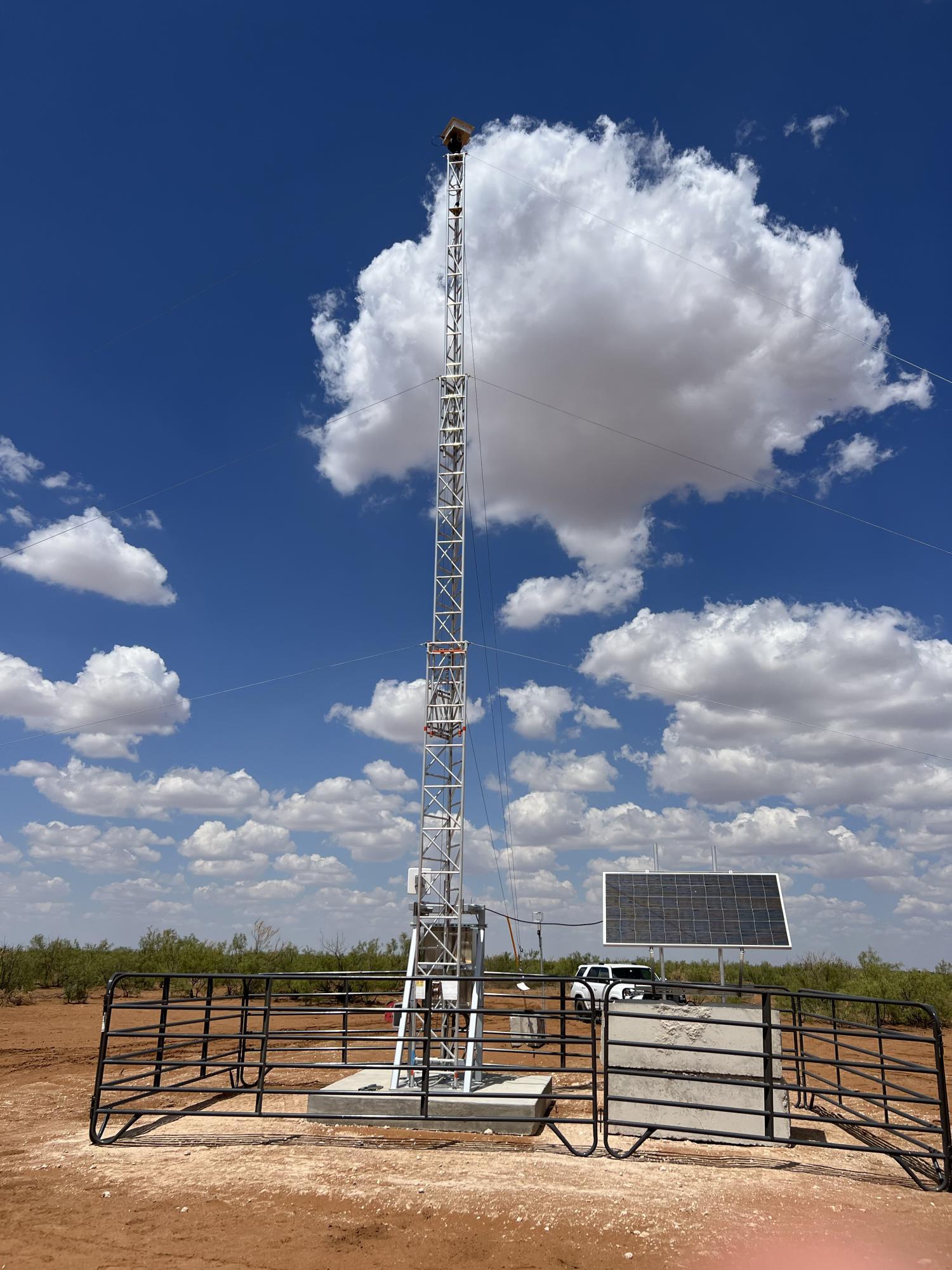LongPath is harnessing quantum technology to detect methane emissions from oil and gas operations, innovation that benefits industry and investors-and the planet. Most recently, LongPath received landmark financial backing from the Department of Energy (DOE) for a loan of up to $189 million to accelerate the scale-up of the company's monitoring systems.
One winter evening in early 2013, Greg Rieker, associate professor of mechanical engineering in the College of Engineering and Applied Science, had a 'eureka' moment. He'd been working late for several nights, beaming a laser light out the window of the National Institute of Standards and Technology (NIST), trying to measure trace gasses in the atmosphere. It was a turbulent test environment compared to inside the lab, but the atmosphere was quieter at night, and he could 'see' the beam better without competition from the sun.
To detect trace gasses, he aimed a laser over one kilometer at a mirror which reflected the light to a specialized dual-comb spectrometer where the data were analyzed. In the return laser signal that night, Rieker saw carbon dioxide-indicated by dips or pauses in a graph on his computer screen-just what the team had spent months looking for. "I remember thinking, 'We're really onto something,'" he said.
That 'something' was a technology that could accurately measure temperature and atmospheric gas concentrations over a 'long path'. Not long after that night at NIST, Rieker began teaching at CU Boulder and split his time between campus and NIST. That's when the Department of Energy (DOE) Advanced Research Projects Agency (ARPA-E) put out a funding call for low-cost ways to monitor methane leaks from oil and gas infrastructure to address environmental impacts.
Rieker answered that urgent need and landed the grant by fusing his open-path sensing with other critical NIST innovations (in work by Ian Coddington, Laura Sinclair and Kuldeep Prasad). He said that close collaboration between CU Boulder engineers and NIST physicists was key. "We were able to work together in a really unique way to think about (what would become the LongPath system) as a sensor," he said.

Illustration showing how trace gases are detected in the field using a mobile dual-frequency comb laser spectrometer. The spectrometer sits in the center of a circle which is ringed with retroreflecting mirrors. Laser light from the spectrometer (yellow line) passes through a gas cloud, strikes the retroreflector and is returned directly to its point of origin. The data collected are used to identify leaking trace gases (including methane), as well as leak locations and their emission rates. Courtesy of LongPath Technologies Inc.
The path to commercialization
When a university startup is created, it is the culmination of years of research and significant work by the founders to build a compelling company vision, strategy and business model. The team at Venture Partners is here to help with each step along the way, including:
- intellectual property (IP) services,
- entrepreneurial training through the I-CorpsTM Hub West,
- a network of industry mentors,
- funding through the Lab Venture Challenge,
- the Ascent Deep Tech Accelerator,
- fast and simple IP licensing through the Licensing with EASE® program,
- and many other resources.
In 2015, Marta Zgagacz, director of licensing for Venture Partners at CU Boulder, began working with Rieker's research team on their commercialization strategy. The researchers partnered with the university on the ARPA-E grant as well as on intellectual property rights and agreements while they were "figuring out the ecosystem around potential products," said Zgagacz. "It seemed like the technology was solving a real problem, and I remember thinking, 'Wow, this team is sorting out a solution that might actually work."
Rieker recalled a busy time juggling a new lab on campus and teaching obligations with starting a company. He valued the crucial support from Zgagacz and others at the university. "No one at CU ever questioned or even implied that what I was doing was a bad idea. And that probably would not be true in other universities," said Rieker. "Leadership has been thoughtful and encouraging, not discouraging or even neutral. That has been fantastic."
In those early days of moving out of the lab and into the field, LongPath's founders-including Rieker, Caroline Alden, Sean Coburn and Robert Wright-also leveraged other commercialization opportunities. They won what's now the Lab Venture Challenge in 2017 and presented at Destination Startup in 2021, both Venture Partners programs. LongPath tapped into additional funding streams through Innosphere Ventures and, after their first commercial deployment, with ARPA-E's SCALEUP Program.
Last year, the company closed out its Series A funding round with $29.5 million, including investment from White Deer Energy, ConocoPhillips, Williams and Buff Gold Ventures, a venture capital fund in partnership with Venture Partners. Sally Hatcher, co-founder and general partner of Buff Gold Ventures, was impressed by LongPath's "unique approach based on advanced optoelectronics" to get decision-makers timely, accurate information. "It's very exciting to see the level of interest from the oil and gas industry and the DOE's strong support of LongPath's growth," she said.
Most recently, LongPath received additional landmark financial backing-a conditional commitment from the DOE Loan Programs Office for up to a $189 million loan guarantee to accelerate the scale-up of the company's monitoring systems across key oil and gas production basins in several western states.
A measurable impact

A LongPath Methane Emissions Overwatch Central Node in Texas. Courtesy of LongPath Technologies Inc.
LongPath's breakthroughs in laser technology and quantum sensing ultimately created a leak detection system now used to do what previous approaches could not: continuously detect invisible-to-the-eye natural gas escaping from pipes on-site at oil and gas facilities. The system is based on a central tower from which lasers are beamed out like spokes on a wheel across the area being monitored.
Finding and patching those leaks is a triple win-in industry cost savings (from $820 to $980 million per year) to air quality and public health. LongPath's technology can identify natural gas leaks that sicken and displace thousands of people each year and cut greenhouse gas (GHG) emissions, particularly methane. A potent GHG, methane can trap nearly 80 times more heat in the atmosphere than carbon dioxide (over a 20-year time frame).
In 2022, atmospheric concentrations of methane reached a record high-the largest annual increase recorded since systematic measurements began in 1983. Research suggests that escaped methane from oil and gas operations accounts for an estimated one-third of global emissions and, according to the International Energy Agency, mitigating those leaks is the most impactful action countries can take to rein in emissions and slow global temperature rise.
"One of the primary company goals is being able to address the methane issue," said Sean Coburn, LongPath research and development manager and senior research associate in Rieker's lab at CU Boulder. "With our company, and through the activities we do to help elevate other technologies, we can have a measurable impact," he said. "It's very meaningful."
Today, LongPath's Active Emissions Overwatch System is live at oil and gas operations in several states, covering hundreds of thousands of acres. Rieker and his team see the impacts of those systems grow each day, and he estimates that each system saves between 40 and 80 million cubic feet of methane each year. "Every time we deploy a new system, it really is impactful," he said. The team still 'celebrates' every large leak located. "We'll nail a big one for a customer, and that's really exciting," said Rieker.
LongPath's mission and capabilities intersect with a critical moment in shifting local, national and global standards and regulations on methane. In November 2023, clamping down on methane emissions was a major topic at the 28th Conference of the Parties to the United Nations Framework Convention on Climate Change (COP28). Delegates there urged more than 150 countries to make firm commitments to cut methane emissions by 30 percent by 2030.
Weeks after COP28, the U.S. Environmental Protection Agency finalized standards to slash methane pollutants from oil and gas operations. "Sharp cuts in methane emissions are among the most critical actions the United States can take in the short term to slow the rate of climate change," they said.
"We feel so lucky to be at right at the top of this wave as it's cresting," said Caroline Alden, LongPath chief scientist. She said the idea of continuous monitoring for methane leaks seemed laughably difficult to many people until recently. "Now that's understood to be the gold standard. It's been a huge sea change," said Alden.
The other long path
The road to LongPath's groundbreaking technology and its recent successes was itself lengthy, explained Rieker. "It's a technology that evolved over so long. It's been touched by many hands," he said. Those hands include John "Jan" Hall and fellow researchers at JILA, a joint institute of CU Boulder and NIST, who first demonstrated their laser frequency comb in 1999.
Hall, now NIST senior fellow emeritus, received the 2005 Nobel Prize in Physics (with Theodor Hänsch) for contributing to the development of laser-based precision spectroscopy. (Roy Glauber also shared the prize that year for his quantum theory of optical coherence.) Hall's optical frequency comb was revolutionary in the world of precise measurement and now has many applications, from atomic clocks to medical diagnostics.
Over the next decade, various NIST researchers built on Hall's innovation. In 2012, Rieker picked up on that work and started using dual-comb spectroscopy as a sensor for measuring temperature and chemical concentrations along the laser path. That work led to his eureka moment in 2013. "It's taken such a huge amount of time to get it all to come together that the name LongPath has taken on another meaning-this long journey that we've been on," said Rieker.
The magic sauce
What are the secrets to LongPath's success? "They had the magic sauce basically, in the form of the right combination of the technology with the right type of problem and, most importantly, the right team," said Zgagacz. Reiker agreed. "The team has been so cohesive over the better part of a decade now. We're all passionate about this, so the grit and 'stick to it'-ness of the whole team has helped," he said.
Reiker added persistence to that list. "That's ingrained into me that I set a goal and then really doggedly pursue, pursue, pursue," he said. "Patience has been the name of the game with this company," said Reiker-in terms of advancing and commercializing the technology, responding to customer needs and biding time as the oil and gas industry began to evolve to use that technology.
Celebrating small wins along the way was also key, said Rieker. "There's little glimmers of hope as you go, because it's really hard, and they're just enough to keep everybody going," he said. "Now, finally, LongPath is flying on its own."






